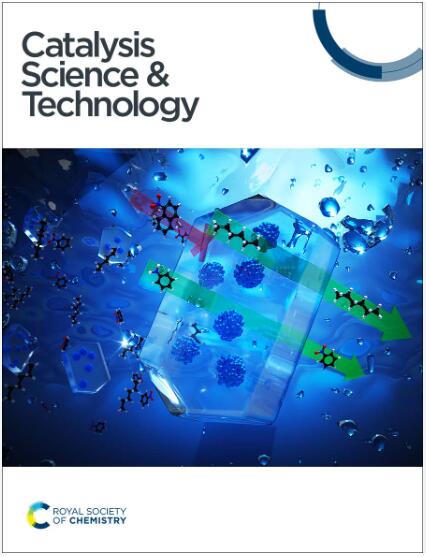温和条件下优选的Ru催化剂对愈创木酚中CAr-OCH3键的选择性裂解
IF 4.4
3区 化学
Q2 CHEMISTRY, PHYSICAL
引用次数: 0
摘要
木质素衍生的(烷基)愈创木酚一锅加氢脱氧制取高选择性的(烷基)环己醇是一种有吸引力的生物质转化工艺。然而,设计出在温和条件下优先裂解醚CAr-O (R)键而不是氢化芳环的催化剂仍然是一个重大挑战。在这项研究中,我们探索了不同粒径(0.6-7.5 nm)负载钌催化剂的结构敏感性,并确定了用于选择性加氢脱氧的最佳催化剂。使用含有1.5 nm Ru颗粒的催化剂,我们在相对温和的条件下(190°C, 5 bar H2)从愈创木酚中获得了约95%的环己醇收率。原位漂移分析表明,在1.5 nm Ru颗粒上,CAr-OCH3键的裂解优先于芳香环的氢化,减少了副反应,提高了环己醇的选择性。本文章由计算机程序翻译,如有差异,请以英文原文为准。

Optimized Ru catalysts for the selective cleavage of CAr–OCH3 bonds in guaiacol under mild conditions†
The one-pot hydrodeoxygenation of lignin-derived (alkyl)-guaiacols to (alkyl)-cyclohexanols with high selectivity is an attractive process for biomass conversion. However, designing catalysts that preferentially cleave etheric CAr–O(R) bonds over hydrogenating aromatic rings under mild conditions remains a significant challenge. In this study, we explore the structure sensitivity of supported Ru catalysts with varying particle sizes (0.6–7.5 nm) and identify the optimal catalyst for selective hydrodeoxygenation. Using a catalyst with 1.5 nm Ru particles, we achieve a ∼95% yield of cyclohexanol from guaiacol under relatively mild conditions (190 °C, 5 bar H2). In situ DRIFTS analysis reveals that the cleavage of CAr–OCH3 bonds occurs preferentially over aromatic ring hydrogenation on the 1.5 nm Ru particles, minimizing side reactions and enhancing cyclohexanol selectivity.
求助全文
通过发布文献求助,成功后即可免费获取论文全文。
去求助
来源期刊

Catalysis Science & Technology
CHEMISTRY, PHYSICAL-
CiteScore
8.70
自引率
6.00%
发文量
587
审稿时长
1.5 months
期刊介绍:
A multidisciplinary journal focusing on cutting edge research across all fundamental science and technological aspects of catalysis.
Editor-in-chief: Bert Weckhuysen
Impact factor: 5.0
Time to first decision (peer reviewed only): 31 days
 求助内容:
求助内容: 应助结果提醒方式:
应助结果提醒方式:


